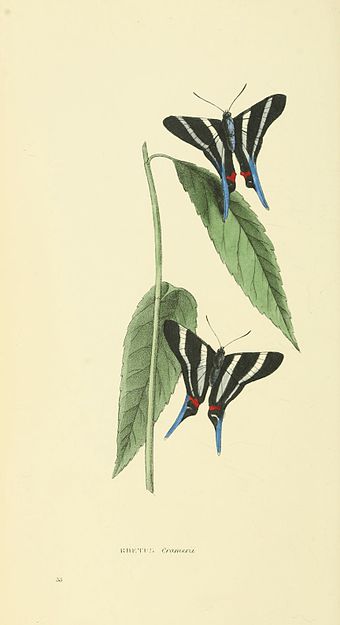Zoological Illustrations Series II/Plate 33
RHETUS Cramerii
RHETUS Cramerii.
Generic Character.
Larva and Pupa unknown.
Wings triangular; the posterior lengthened and rather acutely tailed. Antennæ with the club linear-fuciform. Palpi cylindrical, elongate, porrect, incurved, remote, naked; the second joint remarkably long. Anterior feet in the male short and very hairy; in the female longer, naked, and furnished with minute claws. Wings, when at rest, horizontal.
Types.—Pap. Rhetus. Periander.—(Cramer.)
Specific Character.
Wings black, with two white subhyaline bands, both sides alike; posterior wings elongated, vivid blue, acutely tailed, with a transverse sub-lunular band at the anal angle.
Papilio Rhetus. Cramer. pl. 63, f. c.
This is one of the rarest and most splendid lepidopterous insects of Brazil. We were once fortunate in capturing six specimens, fluttering over a shrub in the early morning sun, during our encampment in the Forest of Urupeè, in the Province of Bahia: but we never again met with this charming creature.
The perfect insect has been figured in the costly, but truly valuable, work of Cramer; yet as neither the larva or pupa are known, we cannot determine on its natural group. Its relations, as suggested by the perfect insect, appear to be these. We consider the analogy between the groups respectively containing P. Podalirius, and Marius (Cr.), to be immediate and direct: the form of the last type, and much of its general structure, is seen in our insect; but the details will not admit of a further similitude. Among the Ericinæ we again detect this form in P. Corineus and Dorylus (Cr.), and continuing the comparison, we see the antennæ, palpi, and feet (in one sex) of Rhetus, accurately represented in those of P. imperialis (Cr.), among the Thecladæ. We therefore suspect, that the real affinities of our insect lie between the two last groups: It seems moreover to have a strong analogy with Leilus. The upper figure is of the male, the under of the female.

